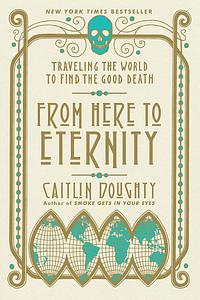Take a photo of a barcode or cover
3.68k reviews for:
From Here to Eternity: Traveling the World to Find the Good Death
Caitlin Doughty
3.68k reviews for:
From Here to Eternity: Traveling the World to Find the Good Death
Caitlin Doughty
It was very fun to read this after having recently read Paul Koudounaris’ Momento Mori, as I had no idea both authors went on the same research trip together (or knew one another)!
Caitlin Doughty shares her travels in a book about death culture from around the world. I enjoyed how this book continually checked in with the American view of death, and asked readers to question what they know and fear. Its exploration into burial practices from the view of a mortician was certainly an added benefit to other death culture books I have read. Doughty provides insights that come from a place of genuine love of death culture, and that feels special.
My only critique of this book is the occasional comment on cultural difference as oddity. Doughty treats the communities she is invited into with respect, as she does the dead she spends time with. But sometimes I felt that the framing of some aspects of a behavior or culture as “weird” was unnecessary, and did more to distance the reader from the feelings the author wants to evoke—of respect, valuing all kinds of relationships to death, and remaining open to the feelings we feel about death.
Overall, a fun read!
Caitlin Doughty shares her travels in a book about death culture from around the world. I enjoyed how this book continually checked in with the American view of death, and asked readers to question what they know and fear. Its exploration into burial practices from the view of a mortician was certainly an added benefit to other death culture books I have read. Doughty provides insights that come from a place of genuine love of death culture, and that feels special.
My only critique of this book is the occasional comment on cultural difference as oddity. Doughty treats the communities she is invited into with respect, as she does the dead she spends time with. But sometimes I felt that the framing of some aspects of a behavior or culture as “weird” was unnecessary, and did more to distance the reader from the feelings the author wants to evoke—of respect, valuing all kinds of relationships to death, and remaining open to the feelings we feel about death.
Overall, a fun read!
challenging
emotional
hopeful
informative
reflective
fast-paced
emotional
informative
inspiring
reflective
medium-paced
challenging
emotional
informative
reflective
medium-paced
While I may be biased as I love Caitlin already as an author and death advocate, this book is charmingly funny and reflective upon the many different ways that humans have decided to grieve and deal with the loss that is death.
Caitlin does a wonderful job of making what can be a difficult topic approachable while being entirely respectful towards the different cultures that she writes about. I would happily recommend this book to anyone and would re-read again to see what I pick up on another read.
Caitlin does a wonderful job of making what can be a difficult topic approachable while being entirely respectful towards the different cultures that she writes about. I would happily recommend this book to anyone and would re-read again to see what I pick up on another read.
Graphic: Death, Grief
informative
inspiring
lighthearted
reflective
fast-paced
Fascinatingly informative with plenty of lightish dark humor, mostly of the author at herself in a relatable way.
emotional
funny
hopeful
informative
inspiring
reflective
medium-paced
I did not know that Crestone, Colorado, and the Shambala Temple near Red Feather Lakes, are the only open air cremation pyres in the United States. The method practiced in Crestone is better for the environments and costs 5% of an average American traditional funeral - essentially, the cost of wood.
Indonesia, Torajan villagers, specifically, on the other hand, has such extensive, theatrical funeral processions. The dead stay with their families for a period of months, or even years, and are tended to by their kin; they change their clothes, wash them, talk to them, everything. They are all “amateur taxidermists,” and mummify their own relatives. The wall between life and death is considered porous, rather than firm; a relationship can be maintained, or built, with the dead, long after their heart stops. They are considered alive long after they stop breathing, until the first animal sacrifice at their funerals; their funerals are open to the public, including tourists. They also remove and unwrap their buried dead, to see them again, bring them gifts, talk to them, years later in ceremony.
Whereas in Mexico, las Días de los Muertos have become representative of struggles of disenfranchised political groups and underrepresented populations, like sex workers, indigenous groups, people who died attempting to cross the border, and the LGBTQIA+ community. Mexico is viewed as “a world leader in practicing engaged public grief.”
The author describes the western funeral industry’s marriage with the word “dignity”; apparently the largest funeral home in the US has a trademark on it. She goes on to describe that dignity is often equated with silence, but in maintaining some melancholic poise, relinquishing our dead demurely, or in lowercase, so to speak, supposedly contributes to that sense of dignity. However, through these stories, she highlights how “acting dignified” or giving someone a “dignified” death bites into opportunities to show the pain of loss, the celebration of life, and the deep pride we have in the person who is known, and is being mourned. It restricts, or even fully represses, the vast spectrum of emotions and reactions felt by the living, and makes them taboo, alongside of process that all of us, will experience. She notes that Americans largely live in denial of death, and as a result, abandon the bereaved to solitary confinement. Our distance from this event makes it so much more scary, hard to process, accept, and live with. According to her, Spanish publisher, “seeing the truth like this is always elegant. It gives you what you deserve as a human being. It gives you dignity.”
How exciting that we get a whole interlude on the invaluable nature of our friend, the whale. “The whale is a valuable necrocitizen.” A very cool thing happening in North Carolina as a funereal option is the Urban Death Project, a process of converting corpses into compost. It may sound a little gross, but rather than just burying your relative in the ground and leaving them there, once they have composted into nitrogen rich soil, they can be given back to the family to use in their own garden and planting. We already do this with livestock! People can also select for a forrest burial, even being buried side-by-side with their spouse in the same section of woods, to mutually renourish the wilderness space. Just like the whale’s body serves the creatures that feed near ocean floor for decades to come, so too can the give back to our communities in a life sustaining way. As well, recomposition of the earth (via decomposition of the self) is a way to reject the merciless measures to prevent aging that are compelled by society, especially for those who have been socialized as women. The author relishes the idea of surrendering to being messy, the breakdown of the body that served her well into the receiving earth, a defiance of patriarchy and male imposition.
I think it’s also important to sever the idea that one has to be productive, or do something meaningful, even after death, amid the capitalist compulsion to be busy or productive, contributing in some way every second of every day. For instance, in Japan, there is a death hotel, where corpses may be housed prior to a funeral, and their relatives can drop in whenever they want, no reservation, no time limit, and spend time in a room with their loved one. And not just a room that is sterile and transitional; rather, a room with flush with arm chairs and couches, television, flowers, and music. There’s also a large bathing facility where the family can bathe their relative before carrying out funeral rides, whenever they’d like to pursue that. There’s an entire attached condominium with microwaves, refrigerators, and futons in futons to host overnight stays for family and extended relatives to spend time with the corpse, before or as a wake. The family is involved completely in each part of the process, and are encouraged to spend time with their loved one, participating in the little intimacies that accompany the transitions of death. And all this without the aggressive imposition of a timeline.
I love the author, and her narration; as a woman who runs an unconventional American funeral home and crematory, she is so funny, sarcastic, contemporary, and deeply empathetic throughout these stories. And of course, she’s a vegetarian, who says she would come back from the dead for a Diet Coke left at her altar. She also expressed her desire for a sky or celestial burial, returning her body to animals for consumption, as it is the least environmentally invasive, expensive, and ethical means of “burial”— then proceeded to detail the fairly horrific process of a celestial burial in Tibet, but I appreciate the ritual, and the immediacy of reintegration with nature.
I think death is really frightening. The experience, the dread, the permanence, all of it. Doughty doesn’t deny this; she advocates for spaces for safe, interactive environments with death, creating a ring of safety that mitigates this dread. I agree that I am a victim of ignorance, lack of exposure, weird and unintimate funerary proceses. This book made me feel really intrigued, rather than afraid, and interested in the possibilities beyond what little I’ve experienced and discussed with others so far about the process and act of dying, and what comes next. All praise to Doughty for making this accessible, curious, and so funny, amid something almost always relegated to sadness and fear. She is the master of her craft.
adventurous
challenging
emotional
funny
informative
inspiring
reflective
medium-paced
adventurous
informative
inspiring
reflective
fast-paced
hopeful
informative
reflective
medium-paced







